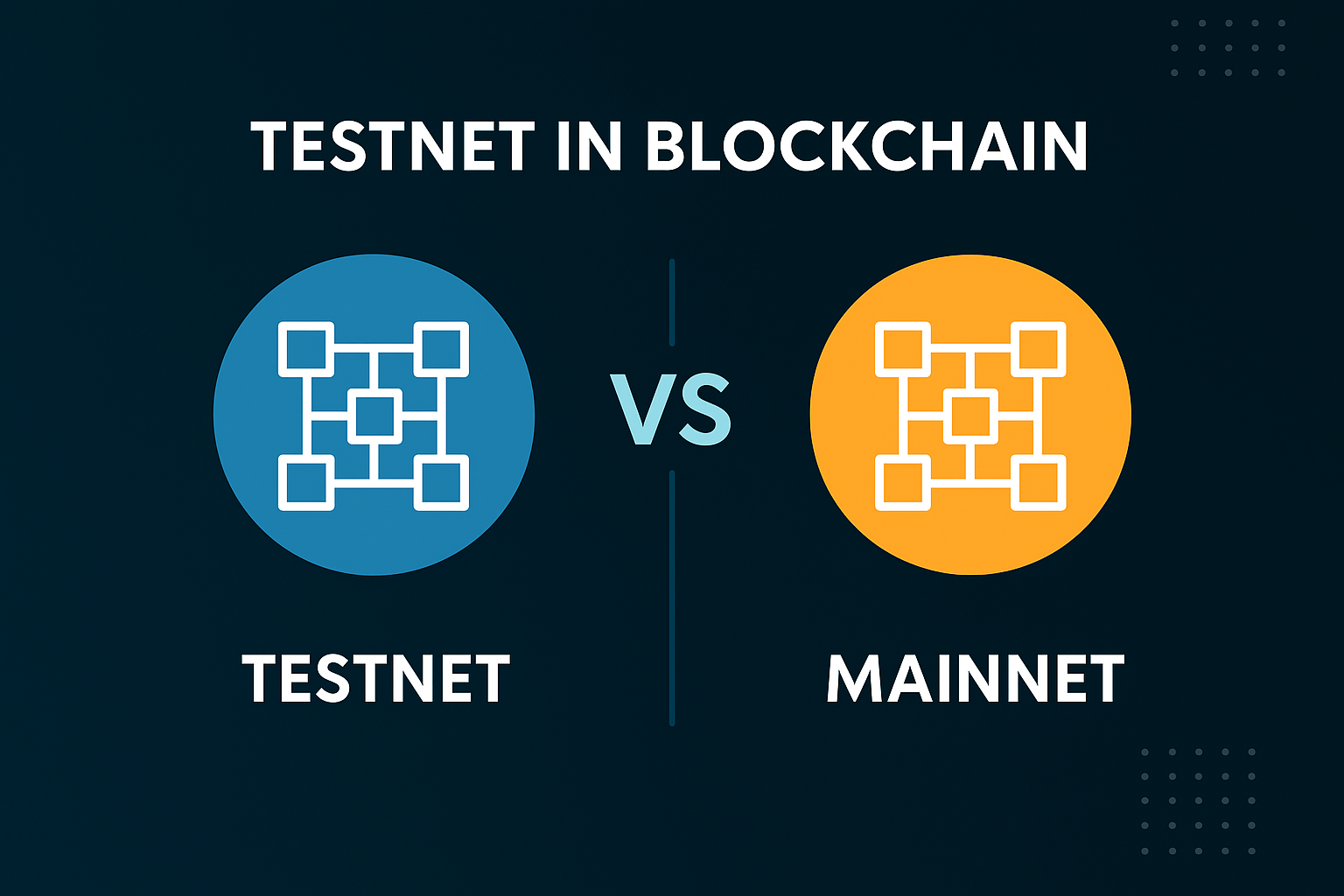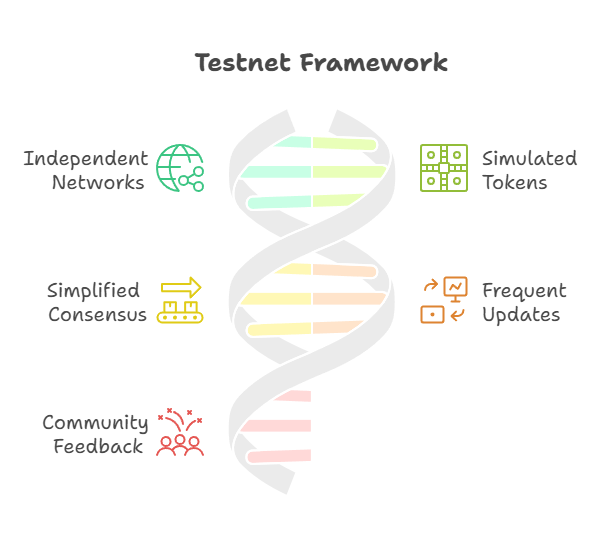Testnet
Before smart contracts and Decentralized Applications (DApps) are deployed to the mainnet, the live production blockchain, a testnet, also called a test network, is a test blockchain network that is primarily intended to serve as a testing environment. Because it functions similarly to the mainnet, developers may test their DApps and smart contracts in a setting that closely resembles the actual blockchain without having to pay real money or take actual risks.
- Cost-effective Testing: To pay for the “gas” of deploying and interacting with smart contracts, it employ free, valueless tokens (such as testnet ETH or tETH) acquired from “faucets.” Rapid testing and iteration are made possible without posing a financial risk.
- Isolated Environment: They provide an isolated space where developers can freely experiment without worrying about potential vulnerabilities or disrupting the main network. This separation allows for a more iterative and agile approach to development, fostering innovation and creativity.
- Issue Identification: Developers can identify and resolve issues, detect errors, system problems, and potential vulnerabilities before granting public access or deploying code on the mainnet.
- Blockchain Code Development: It also facilitate the development of the blockchain code itself, enabling monitoring of changes to ensure it operates within desired parameters.
You can also read Byzantine Failure: Threat to Consensus And System Integrity
Differences Between Testnets and Mainnets

Testnets and Mainnets
Mainnets and testnets are two different, autonomous networks:
- Separate Ledgers: It operate on a separate ledger from the mainnet.
- Valueless Assets: The coins or cryptocurrency on a testnet do not have any impact on transactions or value exchanged on the mainnet, and they hold no real monetary value.
- Distinct Wallet Systems: Most testnets have separate wallet systems to manage coins and transactions outside of the mainnet.
- Distinct Network IDs are used to identify testnets. ID 1, Ropsten 3, Rinkeby 4, Kovan 42, Goerli 6, and Sepolia 11155111 are Ethereum mainnet IDs. With the help of these IDs, contracts are deployed to the appropriate network and wallet systems.
- Transaction Frequency and Public Visibility: It generally do not experience the same transaction frequency as mainnets, and code is not published publicly on testnets due to their changing nature.
- Risk: While mainnet faults and failures can have very substantial and frequently irreversible costs, it offer a risk-free environment.
Distinction from Private Networks
Private networks, as opposed to testnets, are completely new blockchains that are often configured privately and are not a part of the Ethereum infrastructure. Their genesis block and network ID are unique to them. Private networks, which are frequently used for shared distributed ledgers among a private set of entities (permissioned or consortium blockchains), provide greater control over block production for testing and experimentation, while testnets are utilised for testing by the broader public.
Importance and Benefits
Its are indispensable tools in cryptocurrency development:
- Risk Mitigation: They provide a risk-free environment where developers can identify and rectify potential vulnerabilities before deploying their code on the mainnet, significantly reducing the likelihood of security breaches, hacks, or unforeseen technical glitches.
- Smart Contract Testing: A key functionality is the ability to test and deploy smart contracts thoroughly, ensuring their reliability and security before mainnet deployment.
- Consensus Mechanism Testing: Developers can test different consensus mechanisms (e.g., Proof-of-Work, Proof-of-Authority) to evaluate performance, scalability, and security.
- New protocols and network upgrades are evaluated on smaller testnets to find bugs and improve stability.
- Community Engagement: Users and developers can suggest, report, and discuss.
- Iterative Development: It facilitate an iterative development process, allowing refinement of code, experimentation with new features, and implementation of changes based on user feedback.
- Education and Skill Development: They serve as a valuable learning environment for aspiring developers and enthusiasts, offering hands-on experience in blockchain development, smart contract deployment, and network management.
You can also read Ethereum Mainnet: Definition, Purpose And Features
Features
- Simulated Environment: Offers a safe, regulated, and segregated setting for adjustments, testing, and review.
- No Real-Value Assets: Uses tokens with no monetary value, obtained easily through faucets, minimizing financial risk.
- Generally accessible to the public, public accessibility promotes cooperation and community involvement.
- Working on various blockchain system components at the same time is made possible by parallel development.
- Scalability testing: By simulating different loads and situations, it assists in assessing the necessity and viability of scaling a blockchain network.
How it works

How Testnets Work
Testnets work similarly to mainnets but with specific features for experimentation:
- Separate Blockchain Network: They function as independent networks with their own protocols, consensus procedures, and rules.
- Simulated tokens are crucial for repeating transactions and interactions but have no value.
- Consensus Mechanisms: Often use less complicated consensus mechanisms than mainnets to speed up block confirmation and shorten testing cycles.
- Frequent Updates: They are frequently modified and updated to reflect changes in the mainnet, enabling the testing of novel features and performance enhancements.
- Community Engagement: Actively seek feedback from the community through various channels to fix bugs and improve user experience.
Types
Testnets can be categorised into two main types:
- Public Testnets: These are open to the public, allowing anyone to participate in testing and experimentation.`
- Private testnets provide more regulated settings for testing and cooperation, but they are only accessible to a small number of people or organisations.
Popular Ethereum Testnets
Numerous well-known testnets for Ethereum have existed, each with distinct features and consensus systems:
- As the sole Proof-of-Work (PoW)-based testnet before the Merge, Ropsten (ID 3) was most like the Ethereum mainnet. It served both Parity and Geth customers. However, its erratic block times and vulnerability to attacks may make it unreliable. It was the Ethereum Foundation that deprecated Ropsten.
- Only Geth clients could use Rinkeby (ID 4), a Proof-of-Authority (PoA)-based testnet that was renowned for being more dependable and stable than Ropsten. April of 2017 saw its introduction. Moreover, Rinkeby has been deprecated.
- Kovan (ID 42) is a PoA-based testnet like Rinkeby, but its consensus process works with Parity clients. Ethereum Foundation created it in June 2017. They have deprecated Kovan.
- Goerli (ID 6), which was released in November 2018, is compatible with Nethermind, Hyperledger, and both Geth and Parity clients. It also employs Proof-of-Authority. Despite its popularity and the ability to install test Ethereum 2.0 clients, the Ethereum Foundation has declared that it will soon be deprecated.
- In October 2021, Ethereum core engineers established the more recent Proof-of-Authority testnet known as Sepolia (ID 11155111). Following Ropsten’s Terminal Total Difficulty, Sepolia adopted a Proof-of-Stake consensus system to emulate the Ethereum mainnet. Block timings are shortened for quicker transaction confirmation, and it is made to mimic challenging network conditions. Since there is no cap on the total quantity of Sepolia testnet tokens, scarcity is unlikely. The impending deprecation of Goerli makes its use advised.
- Morden: The first Ethereum testnet, which was first introduced as a Proof-of-Work network in early 2015 before being shut down.
- Kiln: The last scheduled testnet prior to the mainnet and Ethereum testnet switching to a Proof-of-Stake consensus system.
You can also read Horizontal Vs Vertical Sharding: Database Scaling Explained
Other Examples
Its are also used by other blockchain networks besides Ethereum:
- Rust-Lightning Testnet (Bitcoin): Designed for implementing lightning network tests on the Bitcoin blockchain.
- The main testing environment for Bitcoin developers is called Testnet3 (Bitcoin), which is a replica of the mainnet but uses fictitious money (tBTC).
- Other noteworthy testnets are Arbitrum Goerli and BSC Testnet.
How to Use a Crypto Testnet Account
The following actions are usually required to use a crypto testnet account:
- Choose a Testnet: Make sure the testnet you choose fits both your development goals and the blockchain environment you are using (for example, Sepolia for Ethereum development).
- Obtain Test Tokens: Get worthless test tokens through a “faucet” or other approved ways. Because they remove budgetary restraints during testing, these faucets are essential.
- Configure a Testnet Wallet: Set up a wallet (like MetaMask) to manage your test tokens and interact with the chosen testnet environment. Ensure the wallet is configured for the specific testnet (e.g., Sepolia).
- Execute Test Transactions: With the testnet wallet, you can deploy smart contracts, carry out test transactions, and communicate with DApps inside the testnet’s boundaries.
- Engage with the Community: Join testnet communities, participate in forums, and contribute feedback to help improve the network.
Usually, developers begin by testing in simulated settings like Ganache or local private nets. After all tests pass, they move to a public it like Sepolia for more realistic testing, and lastly to the public mainnet.
You can also read Contract Account in Blockchain: Importance & Characteristics
